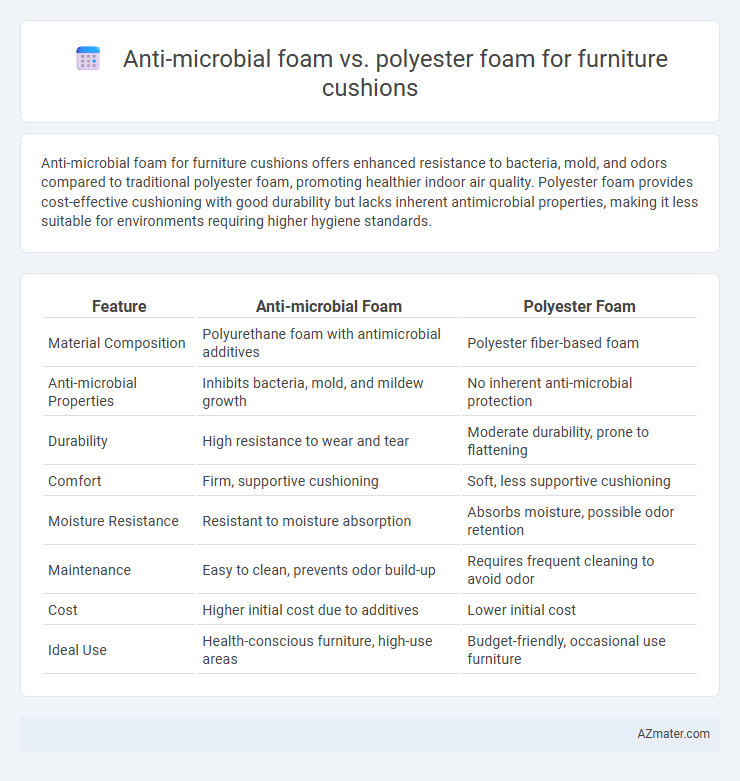Anti-microbial foam for furniture cushions offers enhanced resistance to bacteria, mold, and odors compared to traditional polyester foam, promoting healthier indoor air quality. Polyester foam provides cost-effective cushioning with good durability but lacks inherent antimicrobial properties, making it less suitable for environments requiring higher hygiene standards.
Table of Comparison
| Feature | Anti-microbial Foam | Polyester Foam |
|---|---|---|
| Material Composition | Polyurethane foam with antimicrobial additives | Polyester fiber-based foam |
| Anti-microbial Properties | Inhibits bacteria, mold, and mildew growth | No inherent anti-microbial protection |
| Durability | High resistance to wear and tear | Moderate durability, prone to flattening |
| Comfort | Firm, supportive cushioning | Soft, less supportive cushioning |
| Moisture Resistance | Resistant to moisture absorption | Absorbs moisture, possible odor retention |
| Maintenance | Easy to clean, prevents odor build-up | Requires frequent cleaning to avoid odor |
| Cost | Higher initial cost due to additives | Lower initial cost |
| Ideal Use | Health-conscious furniture, high-use areas | Budget-friendly, occasional use furniture |
Introduction to Furniture Cushion Materials
Anti-microbial foam provides enhanced protection against bacteria, mold, and allergens, making it ideal for hygienic furniture cushions in healthcare and high-traffic environments. Polyester foam, valued for its lightweight, durability, and affordability, offers consistent comfort but lacks inherent antimicrobial properties. Selecting the appropriate foam influences cushion longevity, comfort, and maintenance requirements in residential or commercial furniture applications.
What is Anti-Microbial Foam?
Anti-microbial foam is a specialized cushioning material treated with agents that inhibit the growth of bacteria, mold, and mildew, enhancing hygiene and durability in furniture cushions. Compared to polyester foam, which primarily offers basic comfort and support, anti-microbial foam provides an added layer of protection against odors and allergens. This makes it especially suitable for environments requiring enhanced cleanliness, such as healthcare settings or homes with allergy-sensitive individuals.
Understanding Polyester Foam in Cushions
Polyester foam offers durability and resilience in furniture cushions, providing a supportive yet soft seating experience while retaining its shape over time. Unlike anti-microbial foam, polyester foam does not inherently resist bacteria and mold, making it less suitable for environments requiring enhanced hygiene. Its hydrophobic nature helps reduce moisture absorption, but treating polyester foam with anti-microbial agents is often necessary to improve its resistance to odors and microbial growth.
Key Differences: Anti-Microbial vs Polyester Foam
Anti-microbial foam contains additives that inhibit the growth of bacteria, mold, and mildew, enhancing hygiene and prolonging the foam's lifespan in furniture cushions. Polyester foam, made from synthetic fibers, offers durability and affordability but lacks inherent antimicrobial properties, making it more susceptible to microbial growth. Choosing anti-microbial foam is ideal for environments requiring higher sanitation levels, while polyester foam suits general-purpose cushioning with moderate durability needs.
Health Benefits of Anti-Microbial Foam
Anti-microbial foam in furniture cushions inhibits the growth of bacteria, mold, and mildew, significantly reducing allergens and enhancing indoor air quality. This foam helps prevent unpleasant odors and potential skin infections, making it ideal for sensitive individuals and environments requiring high hygiene standards. Compared to polyester foam, anti-microbial foam offers superior health benefits by promoting a cleaner, safer, and more comfortable living space.
Durability and Longevity Comparison
Anti-microbial foam offers enhanced durability by resisting bacterial growth, mold, and mildew, which significantly extends the lifespan of furniture cushions in high-humidity or high-usage environments. Polyester foam, while cost-effective and lightweight, tends to compress and degrade faster over time, leading to diminished support and frequent replacement. The antimicrobial properties in specialized foams provide a substantial advantage in maintaining cushion integrity, making them more suitable for long-term use in both residential and commercial furniture applications.
Comfort and Support: Which Foam Performs Better?
Anti-microbial foam offers superior hygiene by inhibiting bacterial growth, maintaining freshness while providing consistent support and durability in furniture cushions. Polyester foam, known for its soft and plush texture, excels in initial comfort but may lose shape and support over time due to lower resilience. In terms of long-term comfort and support, anti-microbial foam outperforms polyester foam by combining durability with cleanliness, making it the preferred choice for high-use furniture cushions.
Maintenance and Cleaning Requirements
Anti-microbial foam offers superior resistance to mold, mildew, and bacteria growth, reducing the frequency of deep cleaning and preventing odors compared to standard polyester foam. Polyester foam cushions typically require more regular cleaning with upholstery cleaners and may degrade faster when exposed to moisture and spills. Choosing anti-microbial foam enhances durability and lowers maintenance efforts, especially in high-traffic furniture usage.
Environmental Impact: Sustainability Concerns
Anti-microbial foam often contains chemical additives that may hinder biodegradability, raising environmental sustainability concerns compared to polyester foam, which is more commonly recyclable and sometimes derived from recycled PET bottles. Polyester foam production generally has a lower carbon footprint, especially when utilizing post-consumer recycled materials, contributing to reduced landfill waste. Both foams require careful consideration of lifecycle impact, but polyester foam offers a more eco-friendly option for furniture cushions in terms of sustainability and environmental impact.
Choosing the Right Foam for Your Furniture
Anti-microbial foam provides superior resistance to bacteria, mold, and allergens, making it an ideal choice for furniture cushions in environments requiring enhanced hygiene and durability. Polyester foam, known for its affordability and lightweight properties, offers adequate comfort but lacks the advanced protection against microbial growth found in anti-microbial options. Selecting the right foam depends on your furniture's usage environment and maintenance needs, with anti-microbial foam best suited for high-traffic or allergy-sensitive settings.

Infographic: Anti-microbial foam vs Polyester foam for Furniture cushion
 azmater.com
azmater.com